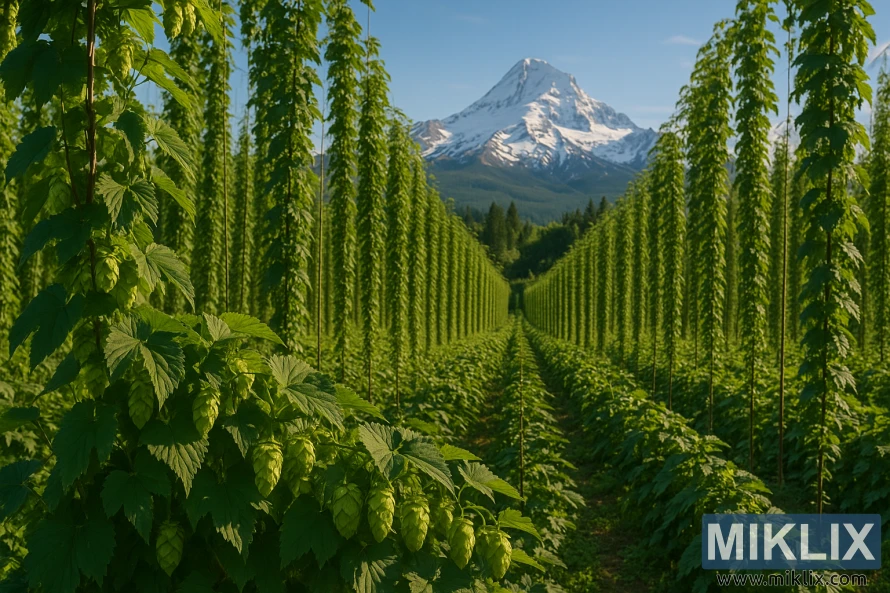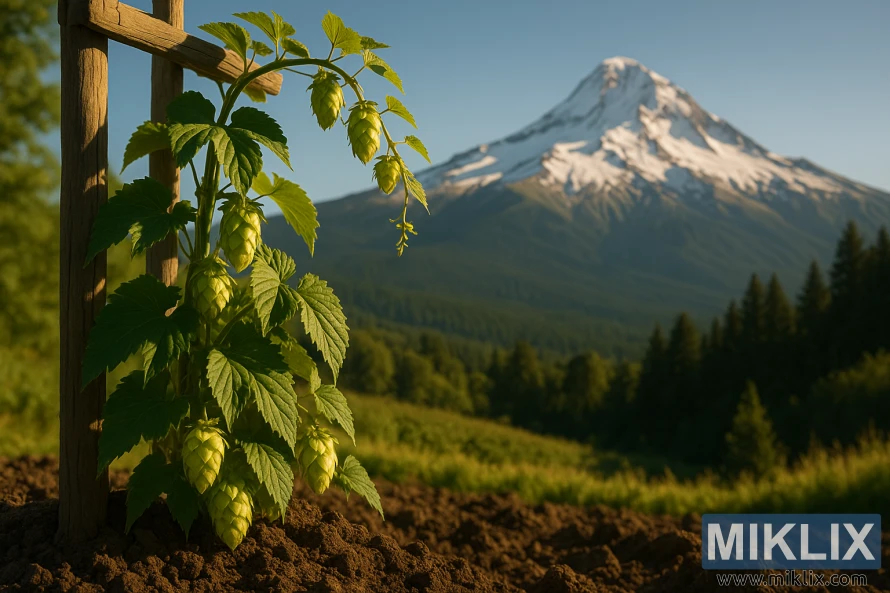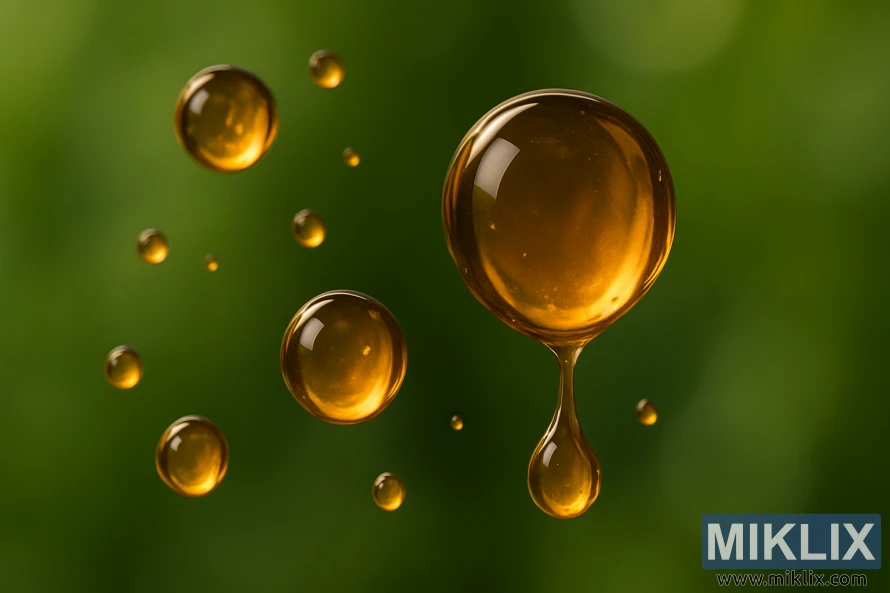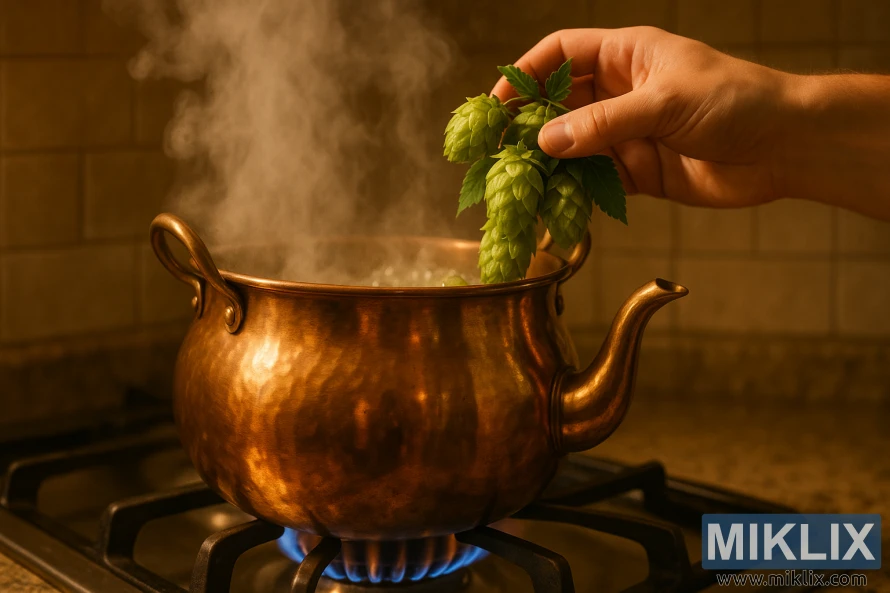Hops in Beer Brewing: Mount Hood
Published: October 21, 2025 at 9:37:53 PM UTC
Mount Hood hops are celebrated for their clean, noble-like character, making them a favorite among craft and home brewers. Introduced by the USDA in 1989, these hops are a domestic alternative to classic European aroma hops. They trace their lineage back to the German Hallertauer line. Known for Mount Hood brewing, this triploid seedling offers a unique blend of mild bitterness and herbal, spicy, and slightly pungent notes. Its aroma profile is often likened to Hallertauer Mittelfrüh. It's ideal for lagers, pilsners, and delicate ales, where subtle floral and noble tones are desired.

Key Takeaways
- Mount Hood hops are a U.S. aroma hop released in 1989 from the Hallertauer lineage.
- The Mount Hood hop variety offers mild bitterness with herbal, spicy and noble notes.
- Mount Hood brewing suits lagers, pilsners and subtle ales that need a clean aroma.
- Harvests for Mount Hood typically begin mid-to-late August in the U.S.
- Hop suppliers commonly support major cards, PayPal and Apple Pay for secure purchases.
Overview of Mount Hood Hop Variety
Mount Hood is a versatile aroma hop, designed to capture the essence of classic European noble varieties. It offers a gentle spice and floral notes. This overview highlights its role in craft and home brewing, as a mild, reliable choice for flavor and aroma.
The origin of Mount Hood hops is rooted in a USDA breeding program. It used a triploid seedling of Hallertauer Mittelfrüh. Released in 1989, it carries the international code MTH and shares lineage with Liberty, Crystal, and Ultra. This explains its noble-like characteristics.
Mount Hood's pedigree showcases its design as an American take on European noble hops. It was bred as a domestic option for bakers of balanced lagers and delicate ales. This gives brewers a local alternative to continental varieties.
Craft brewers value Mount Hood as an American noble-style hop. It offers soft spice, mild floral lift, and light herbal notes. It's ideal for lagers, pilsners, wheat beers, and subtle pale ales, where refined aroma is key.
Availability depends on harvest year and supplier. Hops are sold by established suppliers and retail channels across the United States. Its practical use and steady supply have made it a staple in hop catalogs and homebrew kits.
Botanical and agronomic characteristics of Mount Hood
Mount Hood, a Hallertauer Mittelfrüh descendant, was developed in the USDA program and released in 1989. The goal was to capture the clean, noble aroma of European hops, adapting them to U.S. climates. It bridges classic aroma lines with American growing conditions.
The Mount Hood hop plant is a triploid seedling, showcasing distinct field traits. Triploid hops are known for their strong vigor and reliable cone set. Growers appreciate its steady yields and plant architecture, fitting well with Oregon's trellis systems.
Mount Hood's agronomy benefits from its hybrid background. It exhibits good disease tolerance for a noble-type aroma hop. It performs well under standard irrigation and nutrition programs. Farmers value it for early aroma production and adaptability.
Harvest timing impacts brewing values and oil content. U.S. aroma hops, including Mount Hood, are picked in mid-to-late August. Seasonal variations and harvest dates affect alpha acids and volatile oils. Consistent sampling is crucial for quality control.
Triploid hop characteristics also influence seed development and cone morphology. Mount Hood cones are well-formed with a firm lupulin core. This trait aids in manageable processing at harvest and predictable handling during drying and pelletizing.
Related varieties like Liberty, Crystal, and Ultra share Mount Hood's pedigree. Brewers and growers seeking a noble-style aroma with American robustness often choose Mount Hood. It offers a balance of aroma clarity and field performance.

Analytical brewing values for Mount Hood
Mount Hood alpha acids typically range from 3.9–8%, averaging about 6%. This moderate range allows for both gentle bittering and late additions for aroma.
Mount Hood beta acids usually range from 5–8%, averaging around 6.5%. The balance between alpha and beta acids results in a historical alpha-beta ratio of 1:1. This ratio is crucial for brewers planning IBUs and hop schedules.
hop analysis Mount Hood often shows cohumulone at 21–23% of alpha acids, averaging 22%. This cohumulone level contributes to a smoother bitterness compared to varieties with higher fractions.
- Typical alpha acid cited in many sources: 4–7% for routine recipe work.
- Total oils average 1.2–1.7 mL/100g, commonly near 1.5 mL/100g.
- Oil profile averages: myrcene ~35%, humulene ~25%, caryophyllene ~11.5% and minor farnesene ~0.5%.
Mount Hood HSI values indicate freshness risk. An HSI of 36% (0.36) suggests fair condition and expected acid loss after six months at room temperature. Brewers should monitor Mount Hood HSI when storing whole cones or pellets.
Practical brewing notes from hop analysis Mount Hood highlight its suitability for aroma-focused use. Moderate Mount Hood alpha acids are ideal for late kettle and whirlpool additions. The total oil content and HSI indicate that freshest hops provide the best aroma lift.
Essential oil composition and aroma compounds
Mount Hood essential oils typically measure around 1.5 mL per 100 g of hops. The total oil content can vary, usually between 1.2 to 1.7 mL/100 g. This variation depends on the harvest and the analysis method used.
The main terpenes found in these oils are myrcene, humulene, and caryophyllene. Myrcene makes up about 35%, contributing a resinous, citrusy, and fruity aroma. Humulene, around 25%, adds woody, noble, and spicy notes.
Caryophyllene, at 11.5%, brings a peppery, woody, and herbal character. Minor components like β-pinene, linalool, geraniol, and selinene can alter the overall composition. Farnesene, present at about 0.5%, adds fresh green and floral notes.
This mix of terpenes defines the unique aroma of Mount Hood hops. The profile is mild, with a noble character, subtle floral and herbal notes, and a hint of spice and earth.
For brewers, it's crucial to use late kettle additions and dry hopping. These methods help preserve the volatile myrcene, humulene, and caryophyllene. This way, the beer retains its delicate fruitiness and noble spice.

Flavor and aroma profile associated with Mount Hood
The Mount Hood flavor profile is characterized by a clean, delicate character. It features subtle floral top notes, mild herbal tones, and a soft earthy base. This supports a light bitterness.
Mount Hood aroma descriptors often include herbal, pungent, and spicy notes. These noble-style aroma hops reveal gentle florals with a hint of pepper and clove. This is evident when used late in the boil or in whirlpool additions.
As herbal spicy hops, Mount Hood adds a restrained spice that complements pilsner and lager malts. The spice never overpowers malt or yeast, ensuring the hop's nuance remains clear in the glass.
Brewers find the best expression of Mount Hood comes from late-hop or dry-hop use. This method preserves volatile oils. It delivers the noble-style aroma hops' signature: refined florals, fresh herbs, and faint earthiness.
- Primary notes: soft floral and herbal
- Secondary notes: light spice and earthy undertones
- Best use: late-boil, whirlpool or dry hopping
When blending, Mount Hood pairs well with Saaz or Hallertau derivatives to enhance the noble edge. Its mild bitterness and clean finish make it versatile for classic European lagers and modern farmhouse ales.
How to use Mount Hood hops in the brew kettle
Mount Hood hops are best used for their aroma, making late additions ideal. Adding them in the last 10–5 minutes, at flameout, or in the whirlpool captures essential oils. This method ensures your beer retains its floral, spicy, and herbal flavors.
For a milder bitterness, Mount Hood can be added early in the boil. Its moderate alpha acids provide a smooth, gentle bitterness. This is perfect for creating a subtle backbone without a harsh bite.
For a more pronounced aroma, focus on late-additions Mount Hood and boil additions in the final minutes. A 5-minute hop stand helps preserve delicate esters and prevents oil loss during a long boil.
- Last 10–5 minutes: bright floral and spice.
- Flameout: rounded aroma with less vegetal character.
- Whirlpool Mount Hood: intense aroma with gentle extraction at 160–180°F.
- Early boil: smooth bitterness when needed.
Whirlpool Mount Hood is great for extracting aroma without harsh bitterness. Steeping hops at whirlpool temperatures for 10–30 minutes, then cooling, maximizes aroma. This method also reduces vegetal sulfur notes.
When planning your additions, consider the balance between oil volatility and desired aroma. Combine a small bittering dose with larger late additions for complexity. Use measured late-additions Mount Hood to shape the hop character without overpowering malt or yeast.

Mount Hood hops and dry hopping techniques
Mount Hood hops are a top pick for enhancing late-stage aroma in beers. They release floral, herbal, and mild spicy notes when added post-fermentation. Brewers appreciate Mount Hood dry hopping for its ability to add delicate noble-like flavors without overpowering malt or yeast esters.
To achieve the best aroma, follow dry hop best practices. Use typical dosages based on your beer style and batch size. Homebrewers often start with lower grams per liter, while commercial brewers scale up to grams per hectoliter. It's crucial to control contact time and temperature to manage extraction.
Shorter, cooler dry hop contacts are best for floral and herbal aromas, reducing grassy or vegetal faults. Warmer or longer contact times can enhance leafy notes. For optimal Mount Hood aroma preservation, aim for 24 to 72 hours at cellar temperatures for most ales.
The choice of hop form impacts handling and oxygen control. Since lupulin powders are not available, whole-cone or pellet formats are common for Mount Hood. Pellets are more compact and release oils faster. Whole cones, on the other hand, can be gentler and offer a unique mouthfeel.
- Timing: Add during active fermentation's tail or after fermentation stops for varied effects.
- Dosage: Adjust by style; test small batches to find balance.
- Contact: Short, cool dry hops emphasize floral and herbal notes.
- Form: Use pellets for efficiency, whole cones for subtlety.
By following dry hop best practices and handling with care, Mount Hood dry hopping becomes a reliable method to enhance floral, herbal, and subtle noble traits. Focus on preserving Mount Hood aroma by limiting oxygen exposure and monitoring contact time to maintain the hop's bright and true character.
Beer styles that showcase Mount Hood hops
Mount Hood is versatile, fitting into a variety of recipes. It's used in both lagers and ales to add a mild, noble hop flavor. This enhances the malt and yeast notes without overpowering them.
Classic European styles benefit greatly. It's perfect for pilsner Mount Hood interpretations, Munich Helles, and traditional bock. These styles appreciate a subtle, clean bitterness.
Wheat beers and Belgian-style ales gain from its floral and spicy tones. The hop complements clove and peppery yeast esters without clashing.
- American pale ales and session ales can feature ale Mount Hood for low-to-moderate aroma and soft bitterness.
- Altbier and amber lagers benefit from the hop’s noble-like restraint, aligning with styles for noble hops that demand elegance.
- Pilsners crafted with pilsner Mount Hood emphasize clarity, crisp finish, and a touch of herbal aroma.
When crafting a recipe, consider Mount Hood as a bridge between traditional and modern hops. It brings heritage character to contemporary beers.
For blends, pair Mount Hood with Saaz or Hallertau for an authentic Old World tone. Add a touch of Cascade for citrus lift while keeping Mount Hood’s classic backbone.

Brewing recipe examples using Mount Hood
Mount Hood hops are available in whole-cone and pellet forms, spanning multiple harvests. There's no lupulin powder or Cryo-style concentrates, so recipes focus on late additions and dry hopping. This method captures the hop's floral and herbal essence.
For a clean Mount Hood pilsner, start with a neutral high-alpha hop for bittering to reach target IBUs. Add Mount Hood at 10 minutes for a touch of spice. Then, use a flameout or whirlpool addition to preserve aroma. Finish with 1–2 ounces dry hop for 3–5 days to enhance brightness without dominating the malt.
A practical Mount Hood pale ale recipe takes a different tack. Use Mount Hood as a finishing hop, adding it at 5–10 minutes and a whirlpool charge for a soft noble character. Add 0.5–1 ounce dry hop in secondary for a subtle floral note. This pairs well with pale malt and light crystal.
- 5-gallon Mount Hood pilsner: neutral bittering hops for IBUs, Mount Hood at 10 minutes, 1–2 oz at flameout, 1–2 oz dry hop.
- 5-gallon Mount Hood pale ale recipe: base pale malt, small crystal, Mount Hood 5–10 min and whirlpool, 0.5–1 oz dry hop.
Mount Hood's alpha acid levels typically range from 4% to 7%. If you desire stronger IBUs, adjust boil times or add a higher-alpha bittering hop. Use a recipe calculator to measure bitterness and tweak additions to match your desired profile.
Mount Hood pairing is straightforward. In pilsners, it complements soft lager yeast and Pilsner malt. In American pales, it balances citrus-forward hops or light caramel malts. Mount Hood acts as a bridge between malt sweetness and hop aroma, creating gentle, drinkable beers.
Substitutions and comparable hop varieties
For brewers looking for Mount Hood substitutes, German noble varieties are a prime choice. Hallertau and Hersbrucker offer a mild, herbal, and floral profile similar to Mount Hood. They are ideal for maintaining a soft bitterness and a delicate aroma in lagers and traditional ales.
Mount Hood was developed from Hallertauer Mittelfrüh, making Hallertau Mittelfrüh a suitable alternative. It brings subtle spice, grassy notes, and a clean finish. Adjust the quantities based on alpha acid differences to achieve the desired bitterness.
Liberty and Crystal are practical substitutes for Liberty hops, offering an American twist on noble characteristics. Liberty adds floral and citrus notes, while Crystal contributes light fruit and sweetness. Both can replicate Mount Hood's flavor in late additions or whirlpool hops.
- Closest noble-style match: Hallertau or Hersbrucker for aroma and balance.
- Americanized noble notes: Liberty or Crystal for brighter top notes.
- Adjustments: Scale amounts by alpha acids and aroma intensity; favor late kettle, whirlpool, or dry hop uses.
When substituting hops like Mount Hood, view it as a chance to refine aroma timing. Use smaller dry hop additions to gauge the impact. This method allows you to preserve the beer's original character while introducing subtle new layers.
Purchasing, storage and processing considerations
Secure your Mount Hood hops from trusted sources like farmers' cooperatives or major online platforms like Amazon. Prices and availability can differ significantly among vendors. Always review the supplier's lab sheets for alpha acid, beta acid, and harvest date before making a purchase.
Payment methods are diverse, including major credit cards, Apple Pay, Google Pay, and PayPal. Retailers employ secure payment gateways, ensuring your card details remain protected.
- Compare offerings from Yakima Chief, HopsDirect, Bell’s, or similar suppliers for the best value.
- Confirm seasonal availability; U.S. aroma hop harvests typically occur in mid-to-late August.
- Be aware of alpha acid variability, commonly ranging from 4–7%, and use lab numbers for accurate brew calculations.
Choosing between Mount Hood pellets and whole cones impacts handling and storage. Pellets offer a more compact storage solution and simplify dosing. On the other hand, whole cones may preserve delicate oils better if stored correctly.
As Hop Storage Index (HSI) Mount Hood increases, myrcene, humulene, and caryophyllene levels decrease. An HSI of 0.227–0.5 is indicative of fair condition, roughly translating to 36% in practical terms. The freshness of hops directly influences alpha, beta acids, and volatile oil retention.
Optimal storage for Mount Hood hops involves minimizing exposure to oxygen, heat, and light. Freezing or vacuum-sealing with an oxygen absorber can slow the HSI increase. Use the freshest hops for aroma-forward additions and dry hopping.
- Inspect lab sheets upon receipt and note the harvest year.
- Divide bulk into single-use portions before freezing.
- Keep pellets and whole cones cold and sealed; avoid frequent thaw cycles.
Commercial lupulin powders like Cryo, LupuLN2, Lupomax, or Hopsteiner concentrates are not widely available for Mount Hood. Plan your recipes and hop budgets around either pellet or whole-cone formats.
For beers emphasizing aroma, prioritize late-harvest freshness and low HSI Mount Hood values. Proper storage and handling are crucial to preserve the hops' character. This ensures your purchase performs optimally in the kettle and during dry hopping.
Brewer experiences and comparative uses in IPAs
Many brewers note Mount Hood's clean, herbal, and mildly spicy flavors. It excels when added late in the boil or used for dry hopping. These methods highlight its noble character, avoiding aggressive citrus or tropical notes.
Mount Hood IPA usage focuses on balance. Sierra Nevada and Deschutes use it for a restrained aroma that complements malt and yeast. It provides a soft, classic hop backbone, never overshadowing other ingredients.
When blending hops, comparing Mount Hood to other American hops is crucial. Mount Hood offers herbal tones driven by humulene. In contrast, Citra and Mosaic bring bright citrus and tropical esters, thanks to high myrcene content.
Practical brew choices follow a few patterns:
- Use Mount Hood late or for dry hop to add noble spice without heavy bitterness.
- Blend with high-myrcene varieties like Citra or Mosaic to inject citrus while keeping herbal depth.
- Limit Mount Hood in hop-forward West Coast or hazy IPAs if the goal is loud tropical fruit.
Mount Hood in IPAs is best when used as a supporting actor. Brewers who value subtlety choose it for balanced, classic, and English-influenced American IPAs. Its restrained profile makes it a reliable choice for recipes needing herbal clarity, avoiding overwhelming fruitiness.
Conclusion
Mount Hood summary: This triploid descendant of Hallertauer Mittelfrüh, released in 1989, serves as a noble-style American hop. It offers herbal, floral, and spicy notes, making it perfect for lagers, pilsners, Belgian ales, wheat beers, and pale ales. The analytical ranges (alpha 3.9–8%, oils ~1.2–1.7 mL/100g) highlight its appeal for late-boil, whirlpool, and dry-hop additions.
Using Mount Hood hops is a wise choice for craft and home brewers. It provides a clean, mild bitterness with a classic noble character. For the best aroma lift, focus on late additions or dry hopping. Always check supplier lab sheets for year-specific alpha and oil values. Store hops frozen or vacuum-sealed to preserve volatile oils and reduce HSI degradation.
This noble-style American hop summary highlights its versatility. Mount Hood shines as an aroma accent and subtle bittering hop across various styles. Purchase fresh from reputable suppliers, monitor lab numbers, and use hops late in the process. This way, you can capture the herbal, floral, and spicy nuances that define this variety.
Further Reading
If you enjoyed this post, you may also like these suggestions:
